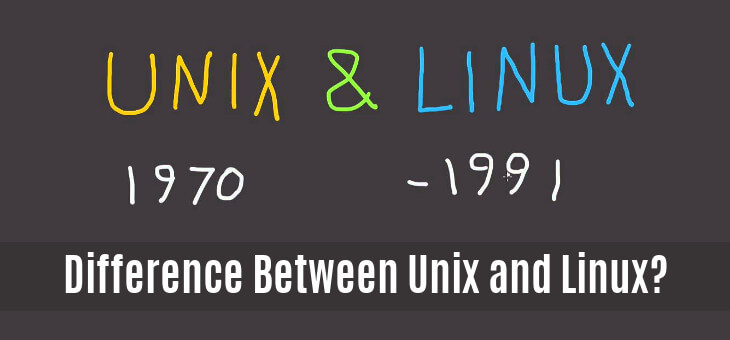

Top 50 Most Asked Linux Interview Questions & Answers
It is most important to know what would be there in terms of Linux interview questions. Most of the cases, many terms, terminologies, and command syntax are asked in the interview or Linux jobs. Linux system is to a significant extent the vast field; thus; having all square knowledge on it is pretty much painstaking. Nevertheless, it is worthy of knowing in detail if you desire to develop a career in this field. Because of being open-source, the Linux system is continuously getting updated by many developers. Hence, professionals and enthusiasts are required to keep studying throughout time.
Most Asked Linux Interview Questions
This article namely; “Linux interview questions” has been written by focusing on the crucial questions that are frequently asked at the Linux job interview. It would be most helpful for Linux applicants, enthusiasts and amateur users who want to know in detail about the Linux.
Q-1: What is Linux?
It is one of the most common Linux interview questions. Linux is UNIX based best known open-source operating system that was introduced in the mid-’90s. It is used in a vast span of the area from individual desktop to the industrial sphere. Linus Torvald designed it, and the primary purpose was to avail the opportunity to use the free operating system on the web platform.
Q-2: What are the Basic Components of Linux?
The basic components of Linux are Kernel, system libraries, shells and GUI, system utilities, and application program. Kernel works for maintaining all functions for the operating system along with processes and virtual memories, whereas system libraries perform some typical tasks that make interrelation with the kernel.
Additionally, shells and GUIs are the interface of the Kernel, responsible for interacting with users and execute kernel’s functions. Application programs are involved with specific tasks that are commanded by the user.
Q-3: What is the Linux Kernel?
Linux kernel is the soul of this operating system; it makes a connection between hardware, software, and the user. It passes the command to hardware through drivers moreover; all the applications that run on the user-mode are interfaced with it. Kernel establishes inter-possess communication to give information that is input by the user.
Q-4: Which was Invented First – Unix or Linux?
It is for sure Unix that was developed in the ’60s and was written with the C programming language. Additionally; the C programming language book was first published in 1977. A relatively close version of Unix was MINIX was released in 1987 for education with a small variant. Linus Torvalds was prompted with all of that creation and developed his Kernel namely; Linux in 1991. What is more, it is another common Linux basic interview question.
Q-5: What are the Similarities and Differences Between UNIX and Linux?
The core difference between Linux and Unix is both are different operating systems; nevertheless; there are some common issues as well.

To begin with; Linux source code is freely available, and it is used for graphically user Interface along with optional Command Line Interface. Being portable, it can be executed in different hard drives. Moreover, as it is flexible thus; it is mainly used in a home-based laptop, computer along a mobile phone too. What is more, it has various versions, namely; Ubuntu, Fedora, Linux Mint, RedHat, and its installation is economical and does not require high-end hardware.
Turning to the Unix, source code is not open, mainly used for Command Line Interface and it is not portable. Having rigid environment hardware, it can be installed in every available machine. Additionally, it works in a server system, high-end computer and mainframes and HP-UX, AIS, BSD, Iris are the various versions of it. Unix installation is expensive, requires specific hardware and supported file systems are gps, xfs, zfs, js, hfx, and vxfs.
Q-6: What are the Benefits of Linux?
Users can be benefitted from Linux in terms of efficiency, stability, flexibility, compatibility, security, and cost. Though Linux is to some extent a little complicated, any user can overcome it and can have efficient service from it. Easily its configuration can be changed, and once if it is done, a sustainable service is guaranteed.
Being available on the open-source, Linux is flexible in addition, compatible as well with many software and applications. It offers security for the private computer by locking down its operating system. Finally, the licensing fee is not required for Linux, although; supportive software can be bought; however; it is not necessary; thus; it is cost-effective.
Q-7: What are the Advantages of Linux as Open Source?
Being the first open-source operating system, Linux offers many advantages for the users. Already, it’s an enriched platform because of the vast contribution of a great range of developers. As an open-source, Linux configuration can be changed very quickly based on the user’s need. Additionally; security is guaranteed in this platform since white hackers contribute positively to overcome the security fault.
Q-8: What is the Operating System Used in Linux?
A Unix-like operating system is an open-source and community-developed used for the Linux. This operating system works for servers, mainframes, computers, mobile devices, and embedded devices. Most of the major computer platforms, including x86, SPARK along with ARM, are supported by this OS; hence; it is branded as one of the broadest supported operating systems. As a basic user, you must not forget this answer as it frequently comes in the Linux jobs as a Linux interview question.
Q-9: What is Zombie Process in Linux?
A zombie process is the leftover of action that already has taken place. Nevertheless; still, it is in existence in the memory and has not been removed immediately after the execution. In this case, the parent process’s interference is required to read the child process’s exit status. Finally, when it gets done with the wait system, it is called a zombie is eliminated. The following diagram shows the process:-
Q-10: What is the Difference Between Process and Service in Linux?
Service is another name of daemon that is continually listening to request and send a response based on the given request, and it works on the background. To put it another way, service is the command that allows start, stop, or restart. On the contrary, the process implies a script or an application that runs in the background or foreground.
Q-11: How to Start, Stop, and Restart Services in Linux?
Just like other operating systems, Linux has its services that work in the background while the system gets the boot and running. When the boot is done, the operating system automatically gets run and works until it is shutdown. However, the user can start, stop, and restart the operating system manually as well. Different commands for a start, stop and restart have been shown in the following:-
Using Systemd to Start/Stop/Restart in Ubuntu
To start a service:
sudo systemctl start ufw
To stop the service:
sudo systemctl stop ufw
To restart the service:
sudo systemctl restart ufw
To check the service:
sudo systemctl status ufw
Note: These commands are a very important part of Linux interview questions.
Using the service command to start/stop/restart on Ubuntu
To start the service:
sudo service ufw start
To stop the service:
sudo service ufw stop
To restart the service:
sudo service ufw restart
To check the service:
sudo service ufw status
Q-12: What Does an “idle” CPU Process Do in Linux?
When all the functions are completed, and the computer processor has nothing to do is called the idle CPU process. Any form of programs that are running in the system takes a certain amount of time in the CPU. However; when the programs are over the CPU is idle. The idle CPU process works for reducing energy consumption by keeping the background engine active.
Q-13: What is the “Parent” Process in Linux?
In the Linux operating system, any process that supplicates fork is called the “parent” process. Based on that, when any particular process is generated is called the child process. Every process except process 0 has the parent process. Moreover, a “parent” process can have one or multiple child processes.
Q-14: How Many Types of Processes are There in Linux?
Three basics processes are categorized in Linux, and they perform different functions in this operating system. The three processes are namely; Foreground or Interactive, Automated, and Daemons. The Interactive Process is responsible for interacting with the user and initiates a process in the terminal prompt. Automated is a scripted process that works on data and time at command.
Q-15: How to See What Services are Running in Linux?
In a different version of the operating system, the service can be checked in different ways. Here I have shown how to check the Ubuntu service status by using Systemd and service command. Always this remains a significant part of Linux interview questions.
Using Systemd on Ubuntu
To check the service:
sudo systemctl status ufw
Using service command on Ubuntu
To check the service:
sudo service ufw status
Q-16: How Does Linux Calculate Load Average?
In Linux, load average is calculated by the decimal number, and it starts from 0.00. The load average implies how many programs had to wait for its turn to run on the system. The load average does not show very instantly; however, it appeared at a particular moment later. The status appears one-minute average, five-minute average, and fifteen minutes average.
Q-17: Which Linux Distro is the Best?
There are lots of Linux distros available in the market. Some of them are very popular among the users and even can work very efficiently to serve the purposes. The popular distributions of Linux are Ubuntu, Linux Mint Cinnamon, Zorin OS, Elementary OS, Linux Mint Mate, and Manjaro Linux. Those forth mentioned distributions are exceedingly capable of specific various functions.
Q-18: Why Linux is Better Than Windows?
Too many significant ways a user would find Linux is mostly better than the Windows. One of the reasons is, source code is open, available, and free; thus; it could be configured the way users need. Nevertheless; this feature is not available for Windows. What is more, the Linux operating system is faster and it tremendously compatible with the latest available desktop features and environment.
Q-19: What is the “Bash” Process in Linux?
Bash is a command processor, Unix shell and command language, interactively works with the users by taking command and transforms it into action. It works as a text window and even from the shell script it can read and executes a command from the files. This command language is widely used in the login file and has been written by Brian Fox. It is worth to mention here that this is a crucial part of Linux interview questions as well.
Q-20: What is the Fork in Linux?
A fork is an operation that responsible for computing specifically in the Linux operating system. It creates its copy that is called the child, and it is implemented in the kernel. Having been created the child process, now either process follows the instruction of the next actions. Furthermore, on the Unix-like operating system, Fork is designed to develop a method in the operating system.
Q-21: What is “Process Priority” in Linux?
When any program is run in the Linux, then the system creates an instance of that program that is called the process. A certain amount of system resources is required for a process, for example; CPU time and RAM to complete tasks of that process. In this system, every process is determined as a “process priority” to calculate the allocated CPU time to execute the functions, and that is “process priority.”
Q-22: What is “Process Status” in Linux?
“Process Status” (PS) is a built-in utility in the Linux operating system that works to inform the continuous programs in the order. Virtual files, namely; /proc the filesystem is the storehouse of current ongoing functions that is read to notify the process status. It is one of the essential administrative features that is used to know what is going on in the operating system.
Q-23: What is the “init” Process in Linux?
Initialization that is abbreviated with “init” is the initial process in the Unix-like operating system which starts working at the beginning of the boot stage and continuously works till the system shuts down. It is a daemon process and ancestor of all other processes directly or indirectly and accepts every different orphaned process too.
Q-24: What is “rc” File in Linux
“rc” can be elaborated with Run Command in the Linux-based system, and it is responsible in command for start information of any files. When a bunch of commands is stored in a file, it facilitates execution with the “runcom” that stands for run command and in this case file is called “runcom.”
Note: Terminologies are part and parcel of Linux interview questions.
Q-25: What is “PR” Command in Linux?
“pr” command that is used in the Linux system is responsible for paginating or culminating files to have a print of it. Additionally, data could be compared by using this command as an alternative method of diff.
Q-26: What is “inode” in Linux?
In Unix-like operating system index node that is known as “inode” works for identifying the file system objects, for instance; either is it file or directory. Disk bock location and objects data are stored in the inode with details attributions that implies metadata, permission data as well as owner name.
Q-27: What is the use of “man” command in Linux?
The “man” command is a manual user works for displaying and formatting the man pages. In the Linux-type system and its various distributions, it comes with a built-in format while the installation is taking place. The man command is responsible for a range of documentation including library routines, the kernel configuration files, and system calls.
“man” command syntax is:
man [option(s)] keyword(s)
Q-28: What Does “pipe” Do in Linux?
“pipe” is a parallel command in the Linux that paves the way of using two commands at the same time. For instance; an output of a particular could be used for the input for another program. To put it; the output of a specific process is straight-forward the input of another process as if it works as a pipe; thus; it is called “pipe” command. Furthermore; it would be wise to believe that it’s one of the potential Linux interview questions all the time.
Q-29: What Does “mkdir” Do in Linux?
In the Linux system “mkdir” smooth the way of creating directories what also known as folders in the various operating system. It is a unique feature to some significant extent; for example; it facilitates creating multiple directories together and asks for permission to access the folders.
“mkdir” command’s syntax is:
mkdir [options...] [directories ...]
Q-30: What Does “ls” Do in Linux?
In a Unix-like system, i.e., Linux, “ls” is a command that works for creating a file list in the order. It generates lists regarding the files that are available in the directories with a little information. It does not show details like file types, last accessed time and date, permission, and so on.
Q-31: What Does “TR” command Do in Linux?
“tr” command is extensively used in the Linux system, and it works for deleting and translating the characters. A far range of functions such as eliminating the specific character, transforming uppercase to lowercase, essential find and replace and squeezing repeating characters are completed with this “tr” command.
Q-32: What is the Linux “Logs”?
What are the functions that have been executed or taking place in the Linux system? “Logs” provide details insights into those functions. It also allows the accessing system, application, and lets the user to troubleshooting when any issue arises. When any problem is found; analyzing the “logs” files is the first step for the administrator.
Q-33: How to Check “Logs” in Linux?
In the Linux operating all files are saved with plain text and can be observed in the /var/log directory and subdirectory. It is the storehouse of Linux logs such as kernel, system, apache, Xorg, boot processes, package managers and MySQL. Linux logs can be viewed by using the command cd/var/log and then by writing “ls” to watch the logs under this directory.
Q-34: How to Play Games on Linux?
Games can be played on the Linux system by downloading the specific game on the steam, a free gaming platform for the Linux user. Many latest and popular Linux games can be found out on that platform. Even a range of native games that are solely developed to play on the Linux system can be found from there. To learn more, please check my comprehensive tutorial on how to play games on Linux.
Q-35: What is “zsh” in Linux?
In the Linux and Unix-like operating system, zsh implies Z shell. This zsh executes its function in the login shell and for the shell scripting; it works as a command interpreter. Lately, this extended brone shell has been primarily improved, and it is featured with the ksh, tcsh, and Bash.
Q-36: Why “zsh” Should Be Used Instead of Bash?
“zsh” includes a large number of features, and it supports themes and plugins. It should be used over the Bash for a couple of reasons, for instance; it is included with automated cd; thus; in the directory, the user can type the name. It is also featured with approximate completion and spelling corrections along with recursive path expansion.
Q-37: Why “top” Command is Used in Linux?
Process activities of Linux are displayed by the top command Moreover; it demonstrates task management in real-time by the kernel. Additionally, it shows all the functions that are being done by the processor and memory and relevant other activities, for example; running the memory process. All those things help the user to take appropriate actions in this regard. Furthermore; it is suggested to learn more regarding different commands since it includes Linux interview questions.
Q-38: Which “File System” is Used in Linux?
The Linux system supports a range of “file system.” Every standard Linux version offers partitioning disks with various file system such as ReiserFS, XFS, Btrfs, ext2, ext3, ext4 and jfs. It is worth to mention here that ext series is an advanced version of the file system, whereas the prominent developer in this industry has developed JFS.
Q-39: What is “journaling” in Linux?
“journaling” file system is used in Linux, and the primary purpose of this file that is called journal is to create a file that restores information regarding data that has been damaged and got corrupted because of malfunctions or improper shutdown of a desktop. The common reason for this interruption might be the power supply or crashed software that cannot be sorted out by rebooting.
Q-40: What is “file descriptor” in Linux?
In Linux, the “file descriptor” is an abstract indicator. Most of the cases, it is a number that is used to access input or output sources and even in the file. In-network socket and pipe command indicates how a data should be obtained if it is required. Commonly, it lets the kernel facilitating access in the global file table and offers the exact location for that software.
Q-41: What Does the “date” Command do in Linux?
“date” and time of system are displayed by the data command In the Linux and Unix-type operating system moreover; it is used to set up time and date for the system. Time and date are displayed according to the time zone by default with the date command. That is how it has been configured. The “date” command syntax is:
date [OPTION]... [+FORMAT]
date [-u|--utc|--universal] [MMDDhhmm[[CC]YY][.ss]]
Q-42: What is “CD” command in Linux?
Change Directory command shortly cd command is very often used in the Linux command line. In the Linux and Unix-related operated system, it is elementary and used for changing the current working directory. The current working directory implies where a user is currently working now, and when the user works with the command prompt, they work in a directory.
cd command syntax: cd [-L | -P [-e]] directory
Q-43: What is “patching” in Linux?
“patching” is a computer tool in Linux, contains updated text files moreover; there is a separate file that is called the patch file. It is a document of small text that works in-between two various versions of a source tree which is consisted of changes. Additionally, the diff program is used, creating the patch that works on the type of diff listing.
Q-44: What does it Mean by Linux Distribution?
Linux system works discretely, and it is not similar to the Widows or Mac. Linux distribution that is briefly called Linux distro, the required software is developed in the open-source project and various programmers around the world. This distribution is featured with the GNU shell utilities, Linux kernel, the X server, a package management system, the desktop environment, an installer, and other services. Precisely, it can be said that it is often there in Linux interview questions.
Q-45: Why Linux is Monolithic Kernel?
In a monolithic kernel, all the services, for instance; device drivers, VFS and file system along with essential operation such as memory allocation, scheduling work side by side sharing the same space like a tight-knit group. It is worth to mention here that the monolithic kernel and microkernel work differently and cannot be compared together.
Q-46: What is Terminal Mode Linux?
Console device provides a terminal that is included block-mode terminals, line-mode terminals, and full-screen mode terminals. When any key is pressed on a full-screen mode terminal, data is sent immediately to the terminal, and the terminal output is displayed somewhere on the screen. Because of this tool, terminal-based applications are facilitated with far advanced interactive, for instance; VI editor.
Q-47: What is the “swap” Space?
If the regular memory space of Linux gets finished, then extra memory is required to place or save a certain amount of data. This temporarily created space is called “swap” space in the Linux system. In this case, some pages move to swap space by creating more memory resources.
Q-48: How do You Access Partitions Under Linux?
Numbers are assigned in the Linux at the end of a particular drive identifier. For instance; if there are three partitions in primary IDE hard drives, in this case, they will be named/numbered, /dev/hda1, /dev/hda2 and /dev/hda3.
Q-49: What are the “hard links” in Linux?
“hard links,” in fact, the same link of the existing file but with another name. Because of the hard links files get organized appropriately. The hard disk does not require any space; thus; data can be stored in different names without losing any space. The “hard link” syntax is given below.
Syntax: ln path/to/file /path/to/hard/link
Q-50: Explain “virtual desktop” in Linux.
On the current desktop, it facilitates alternative services to minimize and maximize various windows. When many programs are running on the desktop, then “virtual desktop” helps to clear the windows instead of minimizing and maximizing. Thus; programs would be restored without any damage.
Finally
The forth-mentioned questions that have been written are the most frequently asked for Linux jobs interview. In different scenarios; applicants have to have specific knowledge in various terms and terminologies and to some extent, the need to know command syntax and technical sense. There are many other Linux interview questions available out there which you definitely try to learn before going for any Linux job.
Finally, readers are being requested to leave their valuable comment regarding this write-up. If you find this article is useful, do not forget to like and share it.























Leave a Reply